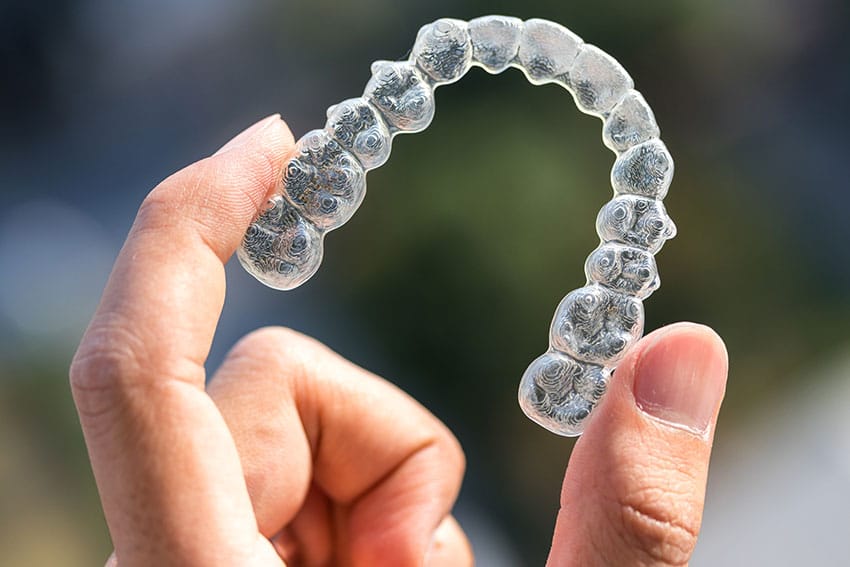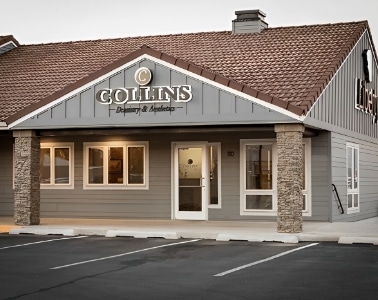Have you been thinking about straightening your teeth? If so, Invisalign clear aligners might be the perfect solution for your needs. At Collins Dentistry & Aesthetics, we help both teens and adults straighten their teeth with Invisalign. The system is discreet, convenient, comfortable, and highly effective. If you’re searching for orthodontic treatment in Spokane, Invisalign might be it!
Before starting treatment, you might have some questions that need to be answered. Please read through answers to the top questions we receive from patients. If any of your questions haven’t been answered, do not hesitate to contact our dental office at 509-532-1111 for more information.
1. What is Invisalign®?
Invisalign is an alternative to traditional braces. It uses clear plastic trays, called aligners, to move your teeth instead of metal brackets and wires. The plastic trays are made of a special plastic designed for Invisalign that does not contain BPA.
2. How Does Invisalign Work?
Invisalign uses a computer program to plot the ideal movement of your teeth from their current position to their ideal position. It breaks this process down into a series of steps. For each step, an aligner is created. You will wear each aligner for two weeks. Then, when your teeth are in the right position, you switch to the next aligner. After you finish the entire series of aligners, your teeth will be where you want them.
3. What Are The Benefits of Invisalign?
Invisalign offers a wide range of benefits. For one, it’s nearly invisible and doesn’t rely on metal brackets and wires like braces. Invisalign is removable for eating and cleaning your teeth, so there are no diet restrictions and no special hygiene procedures. Since there are no wires or brackets, there’s less to irritate your mouth—no sharp edges to poke your cheek.
4. Am I A Candidate for Invisalign?
Most adults and teens who need their teeth straightened can get Invisalign. Invisalign can be used to:
- Close gaps between teeth
- Relieve crowding
- Correct crossbite, overbite, underbite, or open bite
In addition, you should have generally good oral health. If you have significant gum disease or tooth decay, it should be treated before Invisalign treatment begins.
You have to commit to treatment with Invisalign and be willing to follow all treatment instructions. This mostly means taking care of your teeth normally, wearing your aligner for the proper amount each day, and switching to a new aligner on time—not trying to speed up your treatment by skipping aligners or wearing them for too short a time.
The only way to know for sure whether you’re a candidate is to talk to an Invisalign dentist. Please call (509) 532-1111 or email us to schedule your Invisalign evaluation.
5. Can I Get Invisalign if I Have Braces Now, or if I’ve Had Braces in the Past?
Yes. You can normally switch to Invisalign if you are unhappy with your braces. Sometimes, your dentist might recommend braces for part of your treatment and Invisalign for the other part.
People who have had braces but have seen their teeth drift are ideal candidates for Invisalign. You can get your teeth straight again without the trouble of getting braces.
 6. How Long Does Invisalign Take?
6. How Long Does Invisalign Take?
In the past, Invisalign took about as long as braces to straighten your teeth. In some cases, Invisalign is shorter. For other cases, Invisalign might take a little longer. Recent innovations have cut many treatments in half. During your consultation, we will talk about how long your case will take.
7. Will I Have to Wear a Retainer After Invisalign?
With any orthodontic treatment, it’s advised that you wear a retainer to keep your teeth from drifting. Invisalign makes the transition to a retainer easier because your final aligner can serve as a temporary retainer until a permanent retainer can be made.
8. Will My Current Dental Work Affect Invisalign?
Usually not. Reconstructive and cosmetic dentistry are normally not a factor for treatment with Invisalign. Procedures like dental bridges and dental implants can be a problem because of the way they resist movement.
9. How Much Does Invisalign Cost?
We know that the cost of your dental treatment matters, and we work hard to keep costs under control. The cost of Invisalign for you depends on your individual treatment plan. During your consultation, we can discuss costs and payment options to make sure cost is not a barrier to getting the smile you desire.
10. Will My Insurance Cover Invisalign?
Maybe. Insurance plans differ, and some cover the cost of Invisalign while others don’t. Making a claim with your insurance company is one of the payment options we will consider. If your insurance covers a portion of your treatment, we will let you know how much and what remaining costs you need to pay. We can help you set up a payment plan if necessary.
11. How Do I Get Started with Invisalign in Spokane?
That’s easy. To get started with Invisalign in Spokane, please call 509-532-1111 or email us for an appointment with an Invisalign® dentist at Collins Dentistry & Aesthetics.




